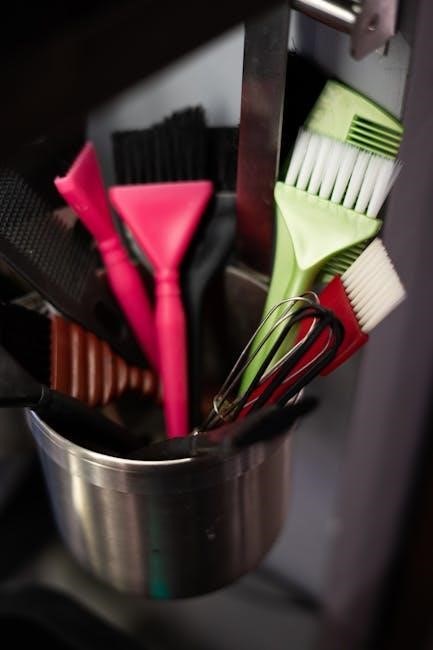gluma desensitizer instructions

Gluma Desensitizer is a one-step solution for reducing tooth sensitivity in exposed cervical areas and teeth prepared for restorations. It creates a barrier over dentin, providing quick relief and compatibility with various restorative materials.
Overview of Gluma Desensitizer
Gluma Desensitizer is a professional dental product designed to treat hypersensitivity in exposed cervical areas and teeth prepared for restorations. It works by creating a protective barrier over dentin, reducing sensitivity to thermal, chemical, and mechanical stimuli. The product is easy to apply and requires no additional curing or agitation, making it a time-efficient solution. Its universal compatibility with restorative materials ensures seamless integration into dental procedures. Gluma Desensitizer is widely recommended for its effectiveness in providing quick and lasting relief from tooth sensitivity.
Importance of Treating Tooth Sensitivity
Treating tooth sensitivity is essential for improving patient comfort and preventing further dental complications. Untreated sensitivity can lead to pain during eating, drinking, and even breathing, affecting quality of life. Addressing sensitivity promptly helps maintain oral health and prevents potential damage to tooth structure. Gluma Desensitizer offers a reliable solution by effectively sealing exposed dentin, thereby reducing discomfort and restoring dental function. Early intervention ensures better long-term outcomes and patient satisfaction.
Key Features and Benefits
Gluma Desensitizer offers a one-step application, universal compatibility with restorative materials, and quick relief from sensitivity, making it an efficient and effective solution for dental professionals.
One-Step Application Process
The one-step application process of Gluma Desensitizer simplifies treatment, saving time and effort. Clean the dentine with pumice under local anesthesia if needed, rinse, and isolate with a rubber dam. Apply the desensitizer directly to the exposed area, ensuring no contact with soft tissues. Air-dry until the gloss disappears, creating a protective barrier. This straightforward method ensures efficiency and effectiveness in reducing sensitivity, making it a convenient solution for dental professionals.
Universal Compatibility with Restorative Materials
Gluma Desensitizer is universally compatible with various restorative materials, ensuring seamless integration into dental procedures. It works effectively with composites, resins, and cements without compromising their bonding properties or the desensitizing effect. This versatility makes it suitable for both direct and indirect restorations, providing reliable results across different clinical applications. Its compatibility ensures that dentists can use it confidently in diverse treatment scenarios, enhancing patient comfort and procedural success.
Quick Relief from Sensitivity
Gluma Desensitizer provides rapid relief from tooth sensitivity by forming a protective barrier over exposed dentin. Its unique formula quickly seals dental tubules, effectively blocking stimuli that cause pain. This immediate action makes it highly effective for patients experiencing discomfort from temperature changes, acids, or other irritants. The fast-acting properties of Gluma Desensitizer ensure optimal results, offering a reliable solution for sensitive teeth and enhancing patient comfort promptly after application.

Instructions for Use
Clean and dry the tooth surface, isolate with a rubber dam, and apply Gluma Desensitizer directly to exposed areas. Avoid contact with soft tissues and rinse thoroughly.
Preparation of the Tooth Surface
Clean the tooth surface with pumice under local anesthesia if necessary, then rinse thoroughly with water. Isolate the area using a rubber dam to prevent irritation of soft tissues. Ensure the surface is dry and free from contaminants before applying Gluma Desensitizer. This preparation step is crucial for effective treatment and to avoid any complications during the procedure.
Application of Gluma Desensitizer
Apply Gluma Desensitizer locally to exposed dentin or prepared tooth surfaces. Use a rubber dam to isolate the area and prevent contact with soft tissues. Gently spread the product evenly, ensuring complete coverage of the sensitive area. Allow the desensitizer to air-dry until the gloss disappears. Avoid rinsing immediately after application to ensure optimal effectiveness. If necessary, rinse with water after 30 seconds to remove excess product.
Post-Application Care
After applying Gluma Desensitizer, rinse the mouth with water to remove any excess product. Avoid consuming hot, cold, or acidic foods and beverages for at least 24 hours to allow the desensitizer to fully seal the dentin. Maintain good oral hygiene practices, including brushing gently with a fluoride toothpaste. Schedule a follow-up appointment with your dentist to monitor the effectiveness of the treatment and address any remaining sensitivity. Proper care ensures long-lasting relief from hypersensitivity. Always follow your dentist’s specific instructions for optimal results.
Clinical Studies and Evidence
Clinical trials confirm Gluma Desensitizer’s effectiveness in reducing hypersensitivity. Studies demonstrate its ability to provide quick, long-lasting relief and compatibility with restorative materials, supported by robust evidence.
Efficacy in Reducing Tooth Sensitivity
Clinical studies demonstrate Gluma Desensitizer’s high efficacy in reducing tooth sensitivity. It forms a protective barrier over exposed dentin, blocking stimuli from reaching the pulp. The product provides immediate and long-lasting relief, addressing sensitivity caused by cold, heat, and acids. Its universal compatibility with restorative materials ensures effective results without interfering with dental procedures. With a simple application process, Gluma Desensitizer is a reliable solution for both direct and indirect restorations, offering quick and sustained comfort for patients.
Comparison with Other Desensitizing Products
Gluma Desensitizer stands out for its one-step application and universal compatibility with restorative materials. Unlike some products requiring agitation or light curing, Gluma offers simplicity and time efficiency. While other desensitizers may focus solely on symptom relief, Gluma also protects the tooth surface, providing a dual-action benefit. Its non-invasive approach and ability to seal dentinal tubules effectively make it a preferred choice over many traditional desensitizing agents, ensuring both immediate and long-term results in reducing sensitivity.
Safety and Precautions
Ensure Gluma Desensitizer does not contact soft tissues; rinse thoroughly with water. Use rubber dam for isolation and avoid ingestion. Follow instructions carefully to prevent irritation.
Contraindications and Warnings
Gluma Desensitizer is contraindicated in patients with known hypersensitivity to any of its components. Avoid contact with soft tissues; use a rubber dam for isolation. Not recommended for non-vital teeth or deep cavities. Ensure proper rinsing to prevent irritation. Do not use as a substitute for professional dental care. Severe sensitivity may require additional treatments. Consult a dentist for persistent symptoms or allergic reactions.
Adverse Effects and Allergic Reactions
Gluma Desensitizer is generally well-tolerated, but rare allergic reactions may occur. Symptoms include itching, redness, or irritation at the application site. In rare cases, patients might experience mild gingival inflammation or sensitivity. If any adverse effects persist, discontinue use and seek professional advice. Ensure proper application to minimize risks. Always review patient history for allergies to dental materials before use to avoid potential complications.
Indications for Use
Gluma Desensitizer is ideal for treating sensitivity in exposed cervical areas and teeth prepared for restorations. It provides quick relief and is compatible with restorative materials.
Exposed Cervical Areas
Gluma Desensitizer is highly effective for treating sensitivity in exposed cervical areas. It creates a protective barrier over exposed dentin, reducing discomfort from stimuli like temperature or acid. The product is applied directly to the affected area, ensuring quick and lasting relief. Its ability to seal dentinal tubules makes it an ideal solution for patients experiencing sensitivity in these regions. This application is particularly beneficial for individuals with cervical erosion or gum recession, providing immediate and noticeable results.
Teeth Prepared for Restorations
Gluma Desensitizer is specifically designed to address sensitivity in teeth prepared for restorations. It effectively reduces discomfort during and after procedures by sealing dentinal tubules. The product is applied directly to the prepared tooth surface, creating a protective barrier that minimizes sensitivity. Its compatibility with various restorative materials ensures optimal results. This makes it an ideal solution for patients undergoing crown preparations or other restorative procedures, providing immediate relief and preventing post-operative discomfort.

Product Composition and Mechanism
Gluma Desensitizer contains active ingredients like HEMA and glutaraldehyde, which block dentinal tubules to reduce sensitivity. Its one-step application creates a protective barrier without requiring light curing.
Active Ingredients and Their Roles
Gluma Desensitizer contains key active ingredients such as HEMA and glutaraldehyde, which play crucial roles in reducing sensitivity. HEMA helps create a protective barrier on the dentin surface, while glutaraldehyde seals dentinal tubules, preventing irritants from reaching the pulp. These ingredients work synergistically to provide immediate and long-lasting relief from hypersensitivity. The unique formulation ensures compatibility with various restorative materials, making it a versatile solution for both direct and indirect restorations. This combination effectively addresses tooth sensitivity while maintaining dental health and integrity.
How Gluma Desensitizer Works
Gluma Desensitizer works by forming a protective barrier on the dentin surface, effectively blocking the dentinal tubules. This action prevents stimuli, such as temperature changes or acidic substances, from reaching the pulp and causing sensitivity. Its active ingredients, such as HEMA and glutaraldehyde, play a crucial role in sealing these tubules, thereby reducing hypersensitivity. This mechanism ensures quick and long-lasting relief, making it an effective and reliable treatment for teeth with exposed cervical areas or those prepared for restorations.

Storage and Handling
Store Gluma Desensitizer at temperatures below 25°C, away from direct light and moisture. Keep the product upright and avoid refrigeration to maintain its effectiveness and shelf life.
Proper Storage Conditions
Gluma Desensitizer should be stored at temperatures below 25°C (77°F) in its original container, away from direct light and moisture. Keep the product upright to prevent leakage and contamination. Avoid refrigeration, as it may alter the product’s consistency. Store in a dry, well-ventilated area, out of reach of children. Ensure the cap is tightly closed after use to maintain product integrity. Check the expiration date on the packaging and use within two years of opening for optimal effectiveness.
Disposal and Safety Measures
Dispose of Gluma Desensitizer according to local regulations for medical waste. Wear gloves and protective eyewear during handling to avoid skin or eye irritation. In case of spills, absorb with inert material and rinse with water. Prevent contact with soft tissues to avoid irritation. Do not dispose of in drains or waterways. Follow all safety precautions outlined in the product’s Safety Data Sheet for proper handling and disposal. Ensure all waste containers are properly labeled and sealed before disposal.

FAQs and Troubleshooting
Q: How long should Gluma Desensitizer be applied? A: Apply for 30-60 seconds. Q: What if it contacts soft tissue? A: Rinse thoroughly with water immediately.
Common Questions About Gluma Desensitizer
Users often ask about Gluma Desensitizer’s application time, which is 30-60 seconds. Another query is its compatibility with restorative materials, and it’s universally compatible. Questions arise if it can be used on sensitive teeth post-restoration, and the answer is yes. Some inquire about its role in preventing hypersensitivity, and it’s confirmed effective. Others ask if it requires light curing, and it does not. Many wonder about its safety, and it’s generally safe when used as directed.
Troubleshooting Application Issues
If Gluma Desensitizer accidentally contacts soft tissues, rinse with water immediately. Incomplete drying of the tooth surface may reduce effectiveness; ensure proper drying before application. If sensitivity persists, reapply as needed. Avoid using Gluma Desensitizer on non-vital teeth or open cavities. For uneven coverage, reapply after rinsing. If irritation occurs, discontinue use and consult a dentist. Always follow instructions carefully to ensure optimal results and minimize potential issues during application.

Video Tutorials and Guides
Watch step-by-step application videos and clinical demonstrations for Gluma Desensitizer. These guides provide detailed instructions for direct and indirect restorations, ensuring proper technique and optimal results.
Step-by-Step Application Videos
Detailed video guides demonstrate the correct application of Gluma Desensitizer. These tutorials cover preparation, application, and post-care steps, ensuring dental professionals master the technique. Videos are available for both direct and indirect restorations, providing clear visual instructions to achieve optimal results and minimize sensitivity effectively.
Clinical Demonstrations and Case Studies
Clinical demonstrations highlight Gluma Desensitizer’s effectiveness in real-world applications. Case studies showcase its success in reducing sensitivity in exposed cervical areas and post-restoration discomfort. Videos and detailed reports illustrate how dental professionals achieve long-lasting results, emphasizing proper technique and patient outcomes. These resources provide practical insights, helping clinicians understand how to integrate Gluma Desensitizer into their treatment plans for optimal results.

Importance of Dentist Consultation
Consulting a dentist ensures proper diagnosis, personalized treatment, and safe application of Gluma Desensitizer, maximizing effectiveness and minimizing risks.
When to Seek Professional Advice
Consult a dentist for severe sensitivity, improper application, or underlying conditions. Professional guidance ensures correct usage, addresses specific needs, and prevents complications, providing safe and effective treatment outcomes.
Customized Treatment Plans
Dentists tailor Gluma Desensitizer use to individual needs, ensuring optimal results. They assess sensitivity causes, adjust application techniques, and integrate it with other treatments for comprehensive care, enhancing patient outcomes and satisfaction.

Purchasing and Availability
Gluma Desensitizer is available at authorized dental suppliers, including dentashop.ru and nika-dent.ru. Purchase from trusted retailers or the Kulzer e-IFU portal for authenticity and quality.
Where to Buy Gluma Desensitizer
Gluma Desensitizer is available for purchase from authorized dental suppliers such as dentashop.ru and nika-dent.ru. It can also be found on the Kulzer e-IFU portal for direct access. Ensure to buy from trusted retailers to guarantee authenticity. For more options, visit the Kulzer website or contact local dental supply stores. Always verify the product’s authenticity to avoid counterfeit items.
Authorized Distributors and Retailers
Gluma Desensitizer is distributed by trusted retailers like dentashop.ru and nika-dent.ru. These platforms ensure genuine products, adhering to quality standards. For authenticity, purchase directly through Kulzer’s e-IFU portal or authorized dental suppliers. Local dental stores with ties to Kulzer also carry the product. Verify retailer credentials to avoid counterfeit items and ensure optimal performance of Gluma Desensitizer in clinical settings.
Gluma Desensitizer effectively reduces tooth sensitivity with its one-step application and compatibility with restorative materials, offering quick relief and long-term protection for hypersensitive teeth.
Gluma Desensitizer offers a simple, one-step solution to reduce tooth sensitivity by creating a protective barrier on exposed dentin. It is universally compatible with various restorative materials, ensuring versatility in dental procedures. The product provides quick relief from sensitivity caused by cold, heat, or acidic stimuli. Its ease of application and effectiveness make it a reliable choice for treating hypersensitive teeth, both before and after restorative treatments, ensuring patient comfort and long-term dental health.
Final Thoughts on Effective Use
Gluma Desensitizer is a highly effective solution for managing tooth sensitivity, offering both simplicity and reliability. Its one-step application and compatibility with various restorative materials make it a versatile tool in dental care. By following proper instructions, dentists can ensure optimal results, providing patients with immediate and long-lasting relief from hypersensitivity.
Regular consultation with a dentist is essential for customized treatment plans, ensuring the product is used effectively and safely. Gluma Desensitizer stands out as a practical and efficient choice for improving patient comfort and overall dental health.




















































